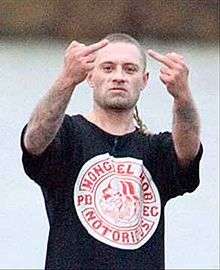Mongrel Mob
 A man wearing a "Mongrel Mob Notorious" T-shirt | |
| Founded | Late 1960s |
|---|---|
| Founding location | Hawke's Bay |
| Years active | 1960s–present |
| Territory | New Zealand, Australia |
| Ethnicity | Mixed, predominantly Māori and Polynesian |
| Criminal activities | Drug trafficking, weapon trafficking, extortion, prostitution, assault, murder, robbery, theft and money laundering |
| Rivals | Black Power, Crips, Road Knights, Satans Slaves, Tribesmen, Killer Beez, Nomads |
The Mongrel Mob is an organised street gang based in New Zealand that has a network of more than thirty chapters throughout the country. They are especially active in King Country, Opotiki and Hastings.[1][2][3] Some of the best known chapters are Mongrel Mob Hastings, Mongrel Mob Porirua and Mongrel Mob Notorious. The Mongrel Mob's main rival is the Black Power gang and there have been several very public and violent clashes between the two gangs over the years.
History
The gang began with a group of mainly European youths from Wellington and Hawke's Bay in the 1960s. Legend within the gang holds that the name originated from the comments of a judge in the Hastings District Court, who referred to a group of men before him as "mongrels".[4][5] Whatever the origin, the group embraced the term. By the late 1960s loose groups of rebellious young men in Wellington and Hawke's Bay were calling themselves Mongrels.[4]
By about 1970 the Mongrels were also known as the Mongrel Mob, and the gang had expanded to include numerous Māori. Members consider Hastings in Hawke's Bay to be the gang's "Fatherland" or birthplace, and the gang first became known for its violence in Hawke's Bay.[4] Later, similarly named groups sprang up around the country, forming their own independent chapters.
In the 2000s and 2010s, the Mongrel Mob is expanding into parts of Australia.[6][7][8]
Membership
Mongrel Mob colours are predominantly red and black. The patches usually feature a swastika and a British Bulldog wearing a German Stahlhelm, which supposedly is an image intended to offend as it is a British Bulldog wearing the helmet. The patch is worn on the back of "patched members" – those considered loyal and trustworthy enough to be in the gang. The patch will also be tattooed on the member's body. Mob members are known for their tattooed faces and red bandannas.
The gang offers a surrogate 'family' for young men, most of whom are often alienated from their family via joining. Members are from New Zealand's Māori, European or other Polynesian ethnic groups, with Māori or part Māori predominating.
A "prospect" is a person who is loyal to the gang but is not a "patched member" yet and must normally do errands or "missions" to show his loyalty to his gang. A "prospect" normally has a "patched member" to report or "clock in" to. This "patched member" normally decides when it is time for the "prospect" to be "patched".
The hierarchy is: captain or president, vice president, sergeant at arms, patched members, prospects. In some cases they use younger blood gangs as prospects.
There were 934 members in prison in April 2013, making up more than a tenth of all New Zealand prisoners.[9] In the Wellington region, there were an estimated 194 "patched members" in 2013.[10]
Involvement in organised crime
At the beginning being a member of the gang was more about having a certain lifestyle and code. At the end of the 1980s certain chapters of the Mongrel Mob began to get increasingly involved in organised criminal activity such as drug trafficking, prostitution and armed robbery.
In media
Ross Kemp on Gangs had an episode about New Zealand gangs which heavily featured the Mongrel Mob.[11]
Starting in 2007, photographer Jono Rotman has featured members of the Mongrel Mob gang in a series of award-winning, traditional portraits.[12]
Notable members
- Dennis Makalio - Senior member, often featured in New Zealand media.[13]
- Tuhoe Isaac - Former senior member often featured in the media.[14]
- Roy Dunn (deceased) - Notorious Mongrel Mob President.[15]
See also
References
- ↑ Collins, Simon (25 July 2006). "Gang shackles define life on the Ford Block". The New Zealand Herald. Retrieved 26 October 2011.
- ↑ Rowan, Juliet (10 March 2006). "Police seize Mongrel Mob arms cache". The New Zealand Herald. Retrieved 26 October 2011.
- ↑ "Police say Mongrel Mob still criminals". Daily Post, 14 December 2006.
- 1 2 3 Gilbert, Jarrod (2013). Patched: The History of Gangs in New Zealand. Auckland University Press. pp. 37–43.
- ↑ "Chapter 3", Jarrod, Patched: The History of Gangs in New Zealand
- ↑ Dowsley, Anthony (1 March 2013). "Evil New Zealand gang comes to Melbourne, and bikies won't like it". Herald Sun.
- ↑ "Mongrel Mob launches Gold Coast chapter". NZ Herald. February 21, 2016.
- ↑ "Rival Kiwi crime gangs Black Power and Mongrel Mob muscle up in Melbourne". The Age. June 1, 2016.
- ↑ Johnston, Kirsty (9 June 2013). "LA-style gangs fuel problems in NZ prisons". Stuff. Fairfax NZ News. Retrieved 9 June 2013.
- ↑ Boyer, Sam. "Mob members half of capital's gangsters". Fairfax NZ News. Retrieved 29 October 2013.
- ↑ "The film the Mongrel Mob didn't want you to see". Stuff.co.nz. 4 May 2008. Retrieved 4 June 2015.
- ↑ "Jono Rotman: Mongrel Mob Portraits". City Gallery Wellington. Retrieved 4 June 2015.
- ↑ O'Neil, Andrea (10 September 2013). "Stand-off over gang patches". Fairfax Media. Retrieved 3 June 2016.
- ↑ "Tuhoe Isaac profile". Rethinking crime and punishment. Robson Hanan Trust. Retrieved 3 June 2016.
- ↑ Kerr, Florence (1 April 2016). "Mongrel Mob Notorious president Roy Dunn remembered". Stuff.
External links
- Images referring to the Mongrel Mob in the collection of the Museum of New Zealand Te Papa Tongarewa